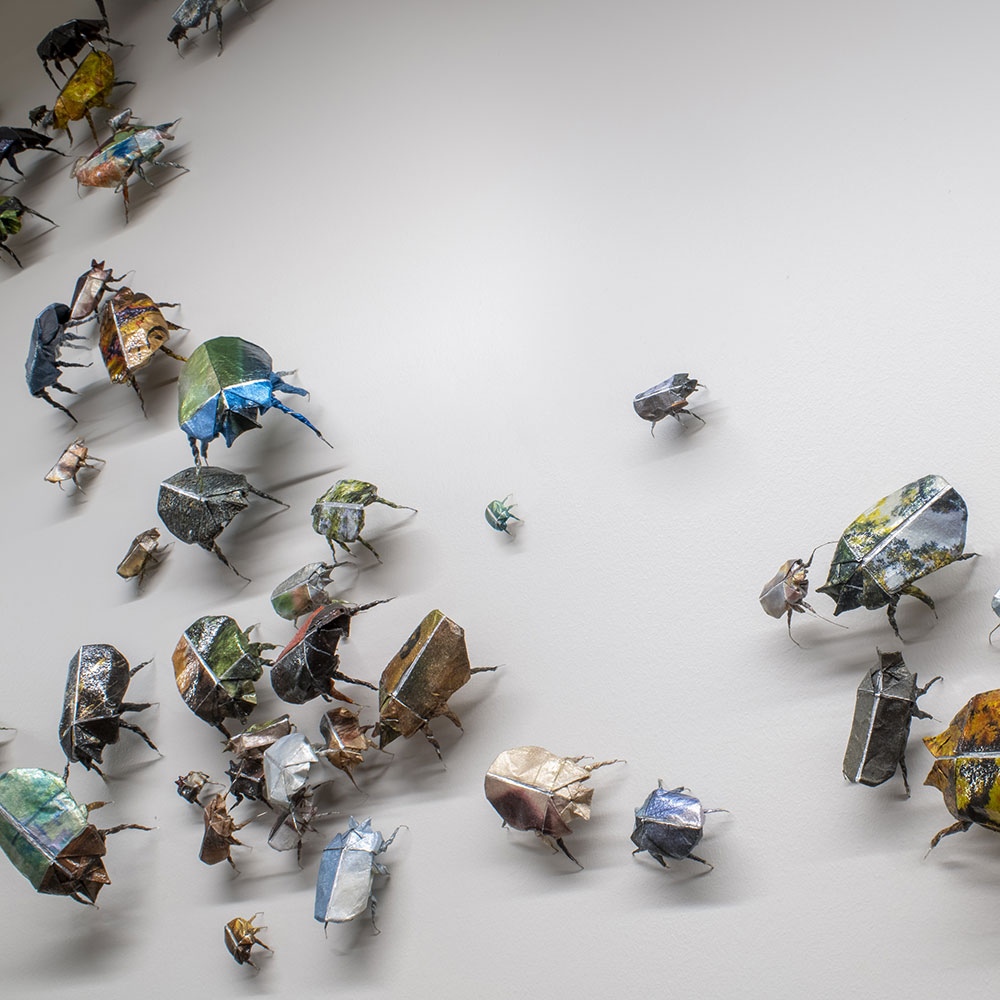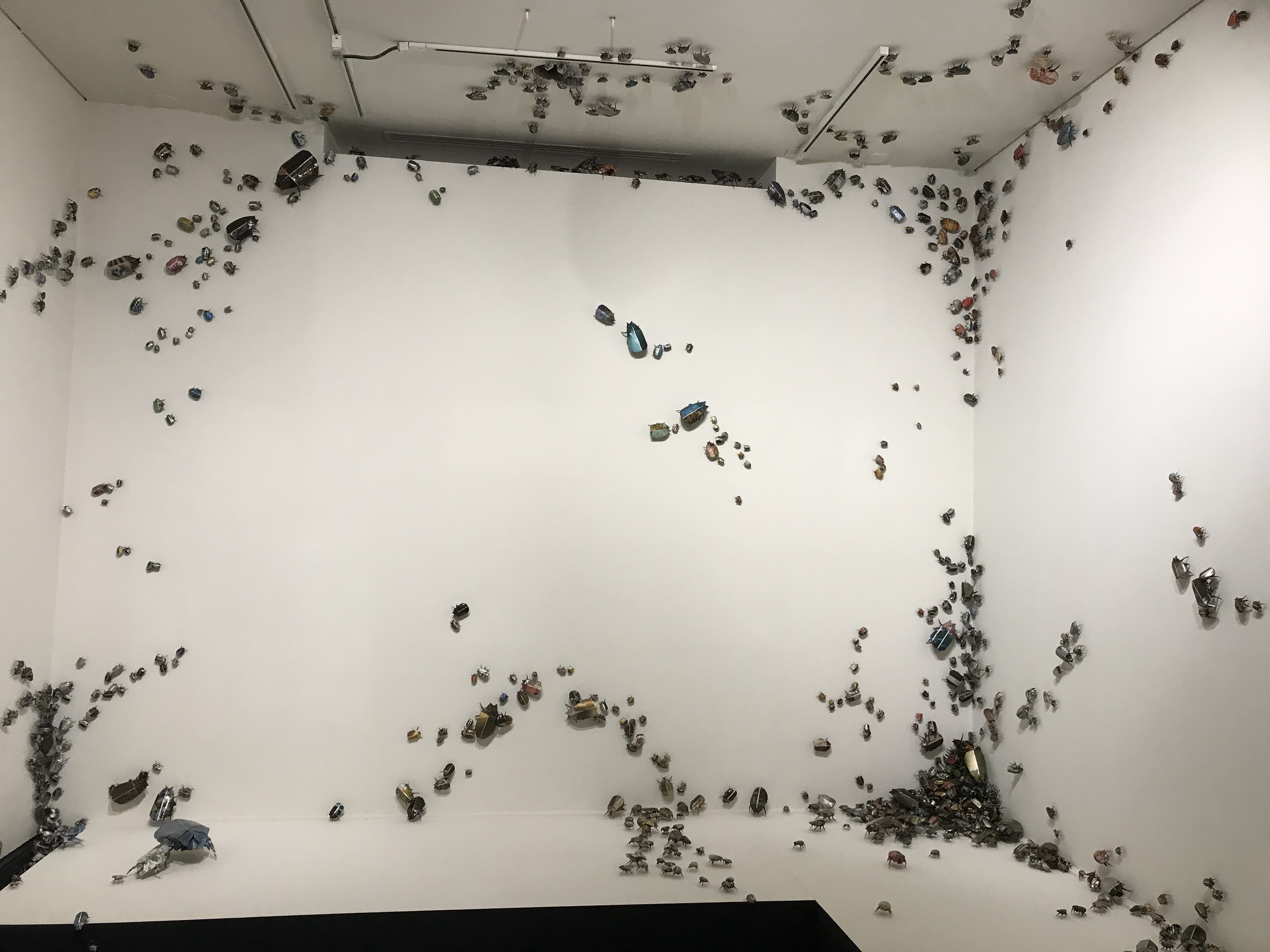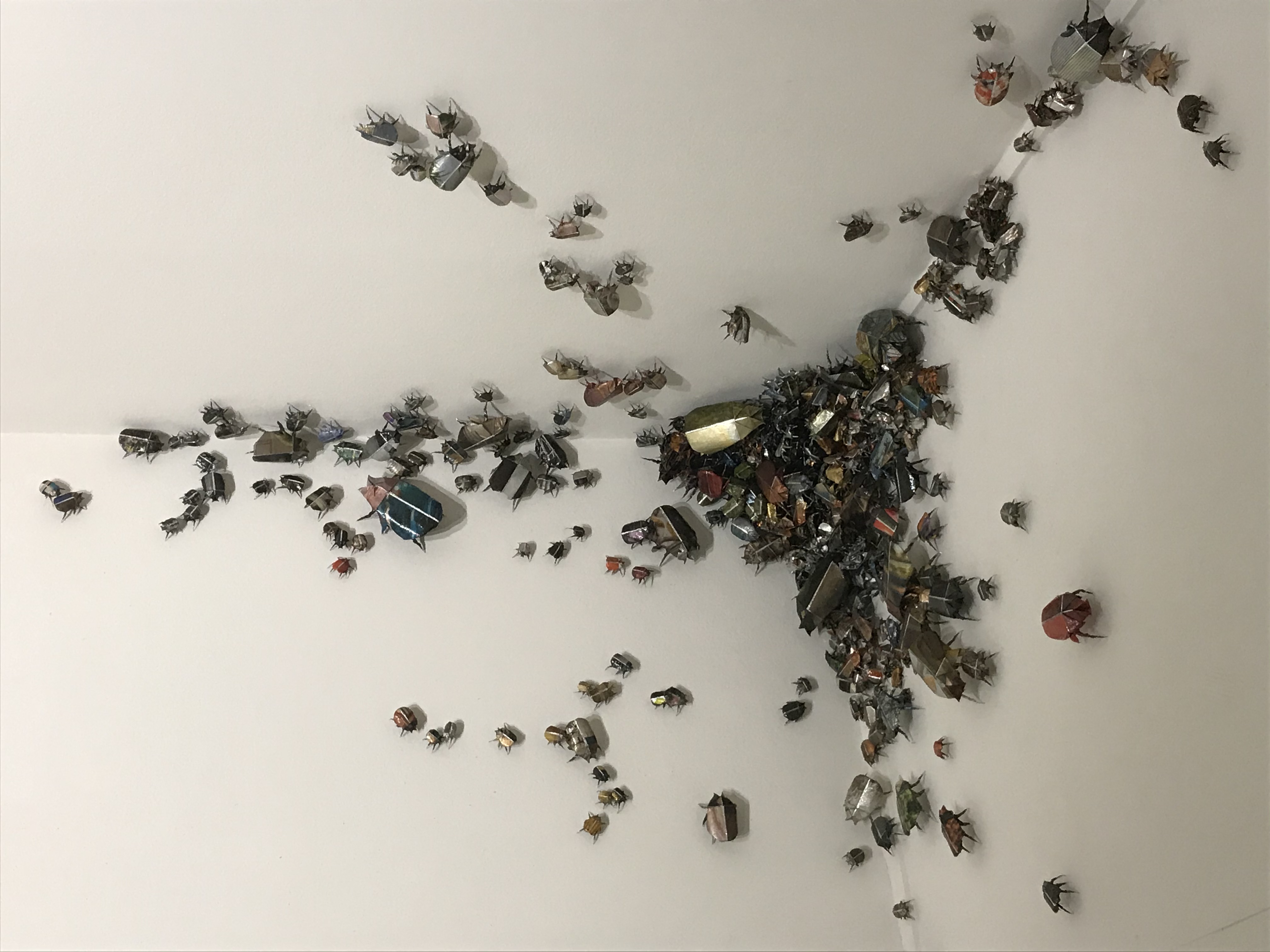Photographer Joli Livaudais combines her love of photography with the art of origami. Her site-specific installation “All That I Love” is composed of over 1,500 paper beetles scurrying across the gallery floor, trailing up the white walls and even the ceiling.
To learn more about site-specific installations, “mixed- media constructions designed for a specific place and for a temporary period of time, I encourage you to listen to either Episode 97 (Chiharu Shiota or Episode 99 (Kathryn Hart), the latter episode includes a conversation with the artist.

Resources for this podcast include the writings of Sean Clancy, the Joli Livaudais website, Museum of Modern Art, Tate Museum and the documentary, “Between the Folds.”


Transcript:
Hello my art enthusiasts. I created and designed a free mini-art history course; an opportunity to take a deeper dive into the works by women artists. “When Women are the Image Makers of the Female Nude” examines the female body through the feminist lens. Your journey includes two women artists; contemporary painter Elisa Valenti who explores body image and photographer Renee Cox and her reclaiming of black/brown bodies from the constraints of gender stereotypes.
Each lesson includes a short presentation of the works, insightful readings and videos plus a deeper exploration through reflective writing. It is your chance to think about what resonated with you in your looking experience. I also include my email address so you can send me your writings for a one-to-one conversation about what you learned. Link to enroll in this free course is in the podcast notes. Enjoy!
Welcome to Episode 102: Joli Livaudais: All that I Love
I am beyond excited to present an artist, whose installation I experienced at the National Museum of Women in the Arts this past November. From the exhibition Paper Routes–Women to Watch in 2020, I am going to focus on Livaudais’ work, All that I Love . The exhibition is outstanding! Paper Routes showcases 22 female, contemporary artists working in paper. “The artists featured respond to the many uses and cultural associations of paper; approaching the medium in varied ways.” In her site-specific installation “All That I Love,” Livaudais combines her love of photography with the art of origami. The installation is composed of more than 1,500 beetles, the insects, trailing across the gallery floor, white walls and even the ceiling. Each beetle is constructed from a photograph printed on paper. In her artistic process, through the time-consuming and physical process of folding each photograph, Livaudais is able to engage in a deep, personal meditation on her past experiences.”
I celebrated women artists who explore the visual expression through site specific installations in this podcast series, including Chiharu Shiota (Episode 97) and Kathryn Hart, (episode 99), the latter includes a conversation with the artist. In these episodes I do go into some depth of what defines an installation including some historical perspective, so I won’t spend time in this episode describing this “genre” of artworks. In the podcast notes, there is links to those episodes and I encourage you to listen to them to learn more about installation art.
Let’s turn our attention to Livaudais work, to the gathering of beetles creeping down from the ceiling, some scurrying farther into the space while some find their way to the other side of the gallery wall. From an interview with Sean Clancy, Livaudais describes her process: A commercial digital photographer by trade, the artist leans towards tactile projects for her fine art like the installation.
Livaudais Says, “I was thinking about the paper and the print and I thought, well, what if we made it an object? What can paper do? “
Each beetle starts as a photograph, often of something personal, “photographs of personal subjects from her own life, like her son Benjamin, other family members, friends, artwork and objects of beauty” or of images from her daily life. “They’re representations of little slices of time that are special to me or beautiful or important to me,” describes Livaudais. The photo is printed on mulberry paper called kozo. Livaudais then bonds it to aluminum foil and folds it into an origami pattern. She says, “The actual folding takes about a half-hour, and I think there are 65 steps to the fold.” She describes the act of folding as “a sort of meditation and a way to have something ongoing. She uses twisted straight pins from a sewing kit for the critters’ legs, which is also how they are affixed to walls and ceilings. Some are also held in place by screws. She then paints them with epoxy resin. “That does two things,” she says, “it hardens the beetle and it saturates that thin mulberry paper so you can see the glimmers of that aluminum base underneath. It makes the beetles appear metallic and iridescent, which is what I was looking for.”
Origami has a rich and complex history that spans culture, class and geography. It transforms a two dimensional paper into a three dimensional form. “There is no cutting, no paste, no tape. Origami is a metamorphic art form. With the piece of paper you do not add to it, you do not take away from it, you change it. The origins of origami, are derived from ancient Japan. Handmade paper was a luxury item only available to a few and paper folding was strictly used for ceremonial purposes until the start of the 15th century where paper folding also became recreational. It was regarded as a new art form and in 1797 written instructions for paper folding became available. Popular was the crane. Paper folding also became a tradition in Europe through the Moors in Spain dating back to the 12th century. The Spanish further developed paper folding into an artistic practice called pajarita. By the 1800s children in Europe and Japan were learning paper folding. Modern origami owes much to a singular figure who revolutionized the artform. Akira Yoshizawa was a grandmaster of origami whose book of new models, published in the 1950s, changed the way people practiced the craft. His standard set of models and diagrams are still used today and international exhibitions of his work helped bring origami to new audiences.
Livaudais brings to her artistic practice the ancient practice of paper folding, employing the imagery of the beetle, their stout bodies hold a legacy and reverence in ancient Egypt as the scarab beetle, a symbol of the sun god Ra. Though Livaudais beetles do not hold or carry the same reverence held by ancient Egyptians, they appear in her work as symbols of spiritual transformation. There is also, from my looking perspective, a sense of whimsy, as my eye moves in and around the installation space. It can be seen in the arrangement of the beetles, but also in the shimmer of their bodies and though the image in the photograph is not discernible to the viewers eye, for me knowing she draws from everyday images, this connects me more deeply to the artist and to her life. The time-consuming physical process of folding each photograph fosters the artist’s personal meditation on past experiences. A part of her is embedded in the creases of every fold and shape. She breathes life into those folds. “Reduced to their elemental parts, the photographs become merely paper,” Livaudais says of her work, “The remnants of the memories they represent are glimpsed only in fragments of sparkling color on the backs of the beetles they have become.”
In an interview for the exhibition, Livaudais reflects on the transformation of a photograph from the spectator’s or viewer’s perspective; reflecting on the difference between experiencing artwork in person, versus seeing it online or in a textbook. This speaks so close to my heart my listeners. She says, “The in person experience can be so consuming, and you notice so many details and translucency and depth of pigment, all these things about the work that you just can’t get any other way. But my medium, photography, is not usually thought of in that sense of, most people think that the experience that they get when looking at a picture online would be identical to seeing that as a fine print in a museum.
But that object nature of the photograph is what started to tease at in my imagination, and I began to get a lot more experimental with how I presented my pictures. And then I started thinking about the substrate, the actual paper, itself, that the photograph was printed on and what could be done with that. And that’s what led me to origami, and this idea of using it to go beyond even the image, to express more with the photograph than I ever could just with the flat image, itself. And I feel like All That I Love, it’s just basically a diary of a life—I feel like it goes well beyond what I could have expressed in a single image.
Livaudais encapsulates so beautifully in that passage, to experience art is to engage with it physically, not through reproductions in digital images. The installation of beetles within a three dimensional space they invade our space, the viewer’s and demand our attention.
Livaudais says, “This art piece is about transformation and appreciating the beauty in life before it ends,” “Each photograph represents a precious moment of something that you love and find beautiful, but you can’t hang on to it forever. You fold it up into a beetle and then let it go, because that’s the way life works.” This just brings me to tears because Livaudais and her multitude of beetles opened up a space for me to see in the impermanence of life, my precious and fleeting moments of beauty that surround my days.
Thank you for listening. Resources for this podcast include the writings of Sean Clancy, the Joli Livaudais website, Museum of Modern Art, Tate Museum and the documentary, “Between the Folds.” You can see the works discussed on my website at beyondthepaint.net and @beyondthepaintpodcast on Instagram.
